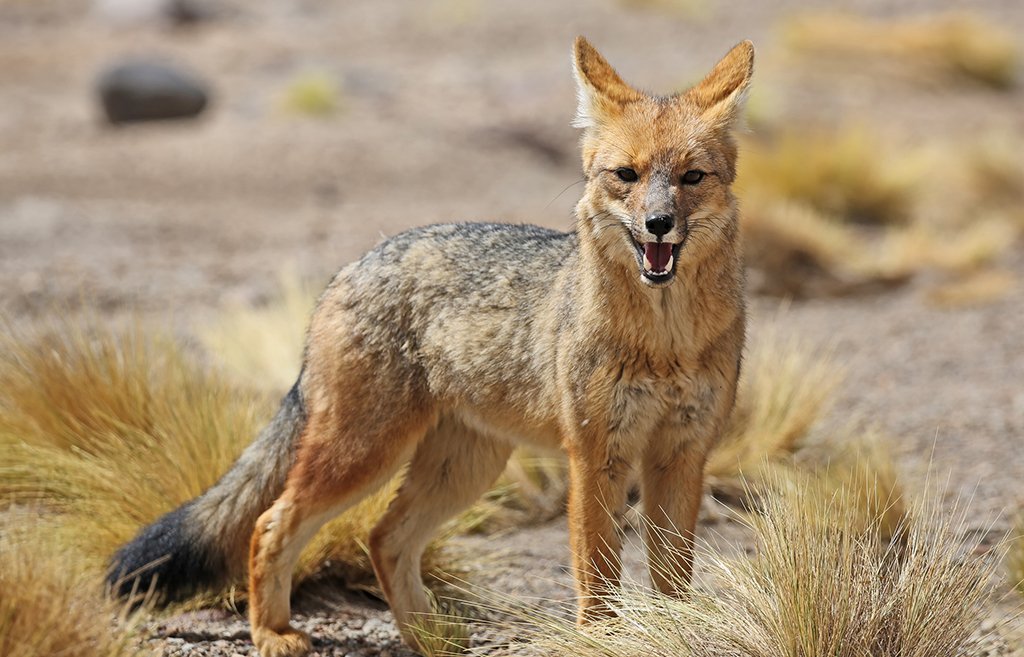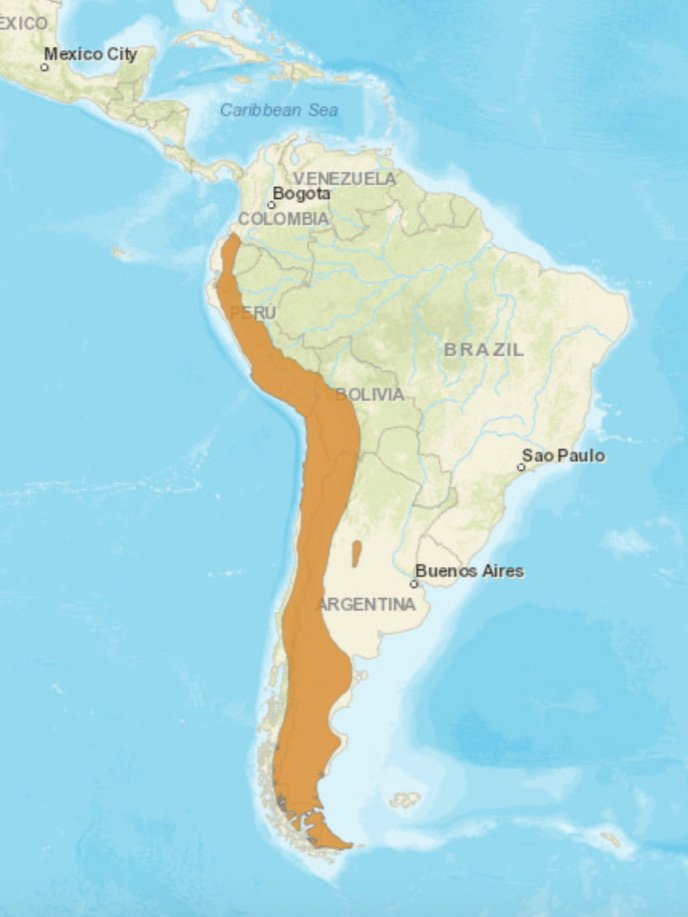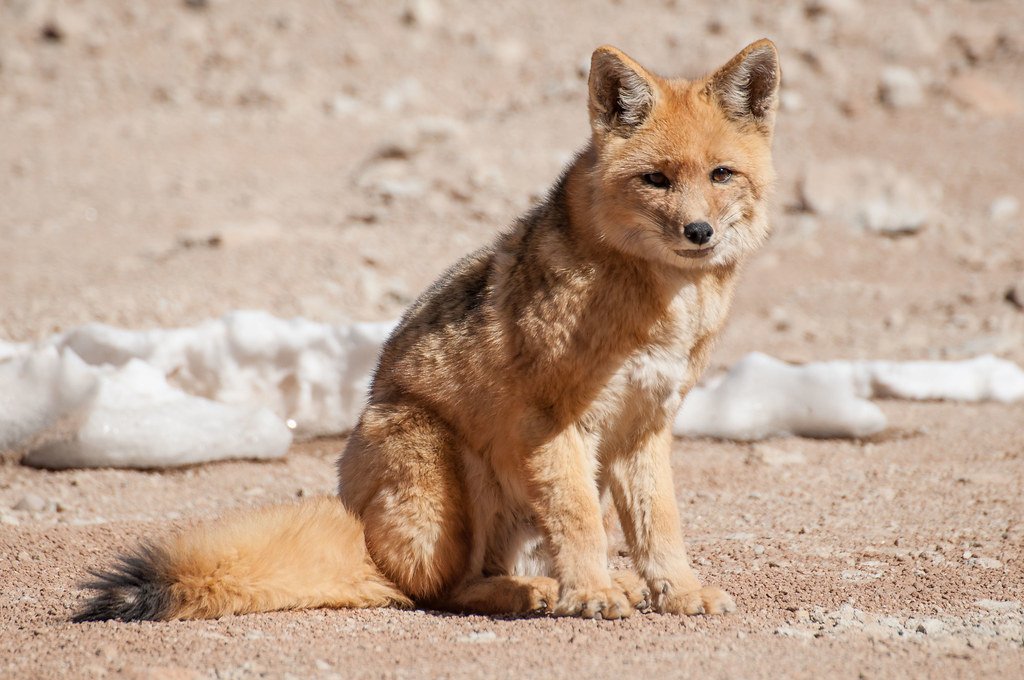Species Spotlight: Culpeo
Lycalopex culpaeus
Common Name: Culpeo
Family: Canidae
Range: Andes from the southern part of Colombia through Ecuador, Peru, Bolivia, and Argentina through the southern Tierra del Fuego archipelago.
Background
The common name “Culpeo” comes from the Mapuche word “culpem” meaning “madness.” This name is a reference to the Culpeo’s often fearless or “mad” appearance, readily making itself known to hunters. Another common name for the Culpeo is the Andean Fox, though this species is not technically a fox but rather it is one of the South American “false foxes” (reflected in the archaic genus name Pseudalopex), which closely resemble the European red fox through convergent evolution. The Culpeo is the second-largest canid in South America behind the Maned Wolf. In the wild, the species’ only natural predator is the puma (Jimenez and Novaro, 2004).
Habitat and Range
Culpeos can be found in the Andes mountains of South America from southeast Columbia to southern Chile and Argentina. As habitat generalists, they are found in a wide variety of biomes, from high mountain páramo grasslands and temperate forests to deserts and deep valleys (Grigusova et al., 2022, Castellanos et al., 2023). They are burrowing animals, making their dens by digging in the ground. Generally, they prefer open areas to those with dense vegetation, thriving in the western Andes.
Behavior and Ecology
Though largely carnivorous, Culpeo also eat fruits and berries, playing a vital role as a seed disperser in the semi-arid parts of their range. Their status as a top predator in the high Andes similarly renders it a crucial member of that region’s ecosystem (Guntiñas et al., 2021).
Culpeos are generally solitary, however they pair up during the breeding season to care for their pups, and related groups have been known to share the same territory. They are known to communicate through a complex network of signals, including scent marking, noises, and gestures (Novaro, 1997). Culpeos’ social habits and behaviors vary based on geographic location–for example, Culpeo populations exhibit crepuscular, nocturnal, or diurnal behavior depending on where in their range they make their home (Guntiñas et al., 2021).
Threats and Conservation
Last assessed in 2016, the IUCN categorizes the Culpeo as Least Concern, however a decline in some populations has been observed (Lucherini, 2016). Additionally, emerging threats including disease and habitat loss due to agriculture and mining development was not considered during the 2016 assessment (See Napolitano et al., 2023). Ecuador’s national red lists designates the Culpeo as a vulnerable species (Castellanos et al., 2023).
The Culpeo is also listed as an Appendix II species under CITES.
Hunting, Trapping, and Persecution
The Culpeo has endured a long history of excessive exploitation for its fur throughout its range (Lucherini, 2016). Data suggests that international trade in Culpeo fur products is on a downward trend, reduced from 1,500 traded in 2,010 to just over 200 in 2021 (CITES Trade Database, 2010-2021.) However, hunting and trapping for commercial use of fur remains prevalent.
Since the Culpeo’s opportunistic diet includes medium to large-sized mammals such as lambs and goats, they are often targeted by farmers, further threatening the species populations (Lucherini, 2016). A popular method used by farmers in Ecuador is poison bait, in which strychnine poison (rodenticide) is infused in eggs and carcasses intended for Culpeos consumption (Guntiñas et al., 2021). This practice impacts not only the locally-threatened Culpeo population, but also internationally-threatened species such as the Andean Condor, which are incidentally killed after consuming poisoned Culpeo carcasses (BirdLife International, 2020). Alternative control methods, such as use of guard dogs and non-lethal repellents, have been successful in deterring Culpeo predation of livestock, while also avoiding both Culpeo mortality and incidental mortality of other threatened species.
Habitat Loss and Degradation
Though the Culpeo is versatile in its habitat and diet, such versatility has its limits. In Peru, habitat disturbance due to overgrazing and mining are recognized as active threats to Culpeo populations (Guntiñas et al., 2021). Since Culpeo populations in Ecuador are particularly adapted to their high-altitude, mountainous biome of the High Andes, habitat disturbance via mining could impact the Culpeo more so in Ecuador than in other locations (Guntiñas et al., 2021). Miners’ practice of putting down tarps at mining sites will also interfere with Culpeos’ burrowing to make underground dens for shelter from the elements and to raise their families. Without a way to make their dens, Culpeos will be unable to thrive in the High Andes any longer. Considering the Culpeo’s critical role in the High Andes ecosystem, such a result would be greatly detrimental to ecological balance in the region.
References
BirdLife International. 2020. Vultur gryphus. The IUCN Red List of Threatened Species 2020: e.T22697641A181325230. https://dx.doi.org/10.2305/IUCN.UK.2020-3.RLTS.T22697641A181325230.en. Accessed on 13 July 2023.
Castellanos, A., Vallejo, AF, and G. Moscoso 2023. Lycalopex culpaeus In: Brito, J., Camacho, MA, Romero, V. Vallejo, AF (eds). Mammals of Ecuador. Version 2018.0. Museum of Zoology, Pontifical Catholic University of Ecuador. https://bioweb.bio/faunaweb/mammaliaweb/FichaEpecie/Lycalopex%20culpaeus , accessed Friday, November 10, 2023.
CITES Trade Database 2010-2021. Compiled by UNEP-WCMC for the CITES Secretariat. Available at: trade.cites.org. Accessed 7 July 2023.
Guntiñas, M., Lozano, J., Cisneros, R., Llorente, E., Malo, A. F. (2021). Ecology of the culpeo (Lycalopex culpaeus): a synthesis of existing knowledge. Hystrix, the Italian Journal of Mammalogy, 32(1), 5-17. https://doi.org/10.4404/hystrix-00388-2020. Accessed 19 Nobember 2023.
Grigusova et al. Higher sediment redistribution rates related to burrowing animals than previously assumed as revealed by time-of-flight-based monitoring. Earth Surface Dynamics. https://doi.org/10.5194/esurf-10-1273-2022.
Jiménez, J.E. and Novaro, J.E. 2004. Culpeo Pseudalopex culpaeus (Molina, 1782). In: Sillero-Zubiri, C., Hoffmann, M. & Macdonald, D.W. (ed.), Canids: Foxes, Wolves, Jackals and Dogs. Status Survey and Conservation Action Plan, pp. 44-49. IUCN, Gland, Switzerland and Cambridge, UK.
Lucherini, M. 2016. Lycalopex culpaeus. The IUCN Red List of Threatened Species 2016: e.T6929A85324366. https://dx.doi.org/10.2305/IUCN.UK.2016-1.RLTS.T6929A85324366.en. Accessed on 13 July 2023.
Napolitano, Constanza & Briceño, Cristóbal & Uhart, Marcela. (2020). Sarcoptic mange: An emerging threat to Chilean wild mammals?. Perspectives in Ecology and Conservation. 10.1016/j.pecon.2020.09.007. https://www.researchgate.net/publication/343636076_Sarcoptic_mange_An_emerging_threat_to_Chilean_wild_mammals. Accessed 19 November 2023.
Novaro, A. 1997. Pseudalopex culpaeus. Mammalian Species, 558: 1-8.





